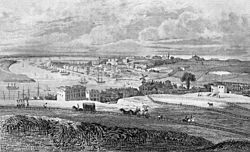Chatham Dockyard
Chatham Dockyard was a Royal Navy Dockyard located on the River Medway in Kent. It was established in Chatham in the mid-16th century. The dockyard was then expanded into neighbouring Gillingham. Chatham Dockyards and its Defences were UNESCO World Heritage Sites.[1]
| HM Dockyard, Chatham | |
|---|---|
| Chatham, Kent | |
| HMS Royal George on the Medway, with HMS Queen Charlotte under construction 1790.jpg Chatham Dockyard in 1790 (by Nicholas Pocock) | |
| Coordinates | 51°23′50″N 00°31′40″E / 51.39722°N 0.52778°E |
| In use | 1567–1984 |
| Open to the public |
as Chatham Historic Dockyard |
| Controlled by | The Navy Board (until 1832); the Admiralty (1832–1964). |
| Events | Raid on the Medway, 1667 |
It existed after the Reformation. It was at a time when relations with the Catholic countries of Europe had worsened, which increased the need for additional defences.[2]
For 414 years, 500 ships were made available for the Royal Navy because of Chatham Royal Dockyard. It was at the forefront of shipbuilding, industrial and architectural technology. At its height, it employed over 10,000 skilled artisans. It covered 400 acres (1.6 km2).
Chatham Dockyard was closed in 1984. The 84 acres (34 ha) Georgian dockyard is now managed as the Chatham Historic Dockyard. It is a visitor attraction by the Chatham Historic Dockyard Trust.
Gallery
Chatham Dockyard Media
The Dockyard as depicted by Robert Dodd in 1789
Engraving of "Chatham Dockyard from Fort Pitt" from Ireland's History of Kent, Vol. 4, 1831. Facing p. 349. Drawn by G. Sheppard, engraved by R. Roffe.
17th-century painting of naval vessels moored on the River Medway, viewed from Chatham with Rochester Bridge in the background.
Dutch Attack on the Medway, June 1667 by Pieter Cornelisz van Soest, painted c. 1667. The captured ship Royal Charles is right of centre.
Armour plating being fitted to HMS Royal Oak at Chatham, c. 1862.
HMS Empress of India in No 8 Dock, with No 1 Boiler Shop in the background, c. 1897.
The Dockyard extension viewed from Upnor, c.1910.
Navy Day at HMNB Chatham, c.1977
References
- ↑ Centre, UNESCO World Heritage. "Chatham Dockyard and its Defences". UNESCO World Heritage Centre. Retrieved 2020-08-14.
- ↑ Archives, The National. "The National Archives - Homepage". The National Archives. Retrieved 2020-08-14.
Notes
- The Annual Biography and Obituary for the Year. Longman, Hurst, Rees, Orme, and Brown. 1835.
- Guidebook. Chatham Historic Dockyard Trust. 2010.
- Beaston, Robert (1788). A Political Index to the Histories of Great Britain and Ireland. Vol. I. G.G.J. and J. Robinson.
- Beaston, Robert (1806). A Political Index to the Histories of Great Britain and Ireland. Vol. I. Longman, Hurst, Rees and Orme.
- Brayley, Edward Wedlake; Britton, John (1808). The Beauties of England and Wales, Or, Delineations, Topographical, Historical and Descriptive of each County. Vernor, Mood and Sharpe.
- Eastland, Jonathan; Ballantyne, Iain (2011). HMS Victory – First Rate 1765. Barnsley: Vernor, Mood and Sharpe. ISBN 978-1-84832-094-9.
- MacDonald, Janet (2010). The British Navy's Victualling Board, 1793-1815: Management Competence and Incompetence. Boydell Press. ISBN 978-1843835530.
- Marshall, John (1824). Royal Naval Biography; Or, Memoirs of the Services of All the Flag-officers. Longman, Hurst, Rees, Orme, Brown and Green. p. 48. ISBN 9780665375859.
Commissioner of Chatham Dockyard.
- Perrin, William Gordon (1918). The autobiography of Phineas Pett. Naval Records Society.
- Saunders, A. D. (1985). Upnor Castle: Kent. English Heritage. ISBN 978-1-85074-039-1.
- Sephton, James (2011). Sovereign of the Seas: The Seventeenth Century Warship. Amberley Publishing. ISBN 978-1445601687.
Other websites
| Wikimedia Commons has media related to Lua error in Module:Commons_link at line 62: attempt to index field 'wikibase' (a nil value).. |
















